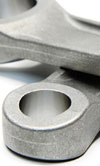Con Rod Bearing Bores
 The big end bearing is critical to the operation and reliability of the four-stroke racing engine. At lower levels of racing, it is possible to run with standard road-going shells of good quality (provided of course that they are rated highly enough to cope with the service loads). After this, special uprated bearings are required. On the RET Monitor website, Anne Proffit has written several articles which discuss the construction and materials of bearing shells.
The big end bearing is critical to the operation and reliability of the four-stroke racing engine. At lower levels of racing, it is possible to run with standard road-going shells of good quality (provided of course that they are rated highly enough to cope with the service loads). After this, special uprated bearings are required. On the RET Monitor website, Anne Proffit has written several articles which discuss the construction and materials of bearing shells.
The reliability, function and precision of these bearing shells rely greatly on the quality and accuracy of the bearing housing, its correct design and manufacture and method of bearing retention.
In a two stroke con rod, which invariably runs rolling-element bearings, con rod manufacture is relatively simple as the bearing bore is finished without having to consider the split which is a feature of the four-stroke con rod.
However, when we consider a four-stroke engine running bearing shells, the con rod is machined with a ‘race-track’ shaped (more like Homestead than Spa!) bearing bore before the rod is split. Once the rod has been split by machining or other means, the two halves are clamped together again, the ‘straights’ on the racetrack shape having been removed as part of the splitting process. The load in the bolted joint at this point is critical; it must be the same as will be used when the con rod is installed. If it is significantly different, the bearing bore will be distorted in service. Once the rod is bolted, final machining of the bore is completed, by precisely boring to size, and perhaps a honing operation.
There are other design features to consider within the big end bearing bore, concerning clearance to adjacent components, bearing retention and lubrication, but more of these at a later date.
One point that we need to consider is that of stiffness of the bearing housing in the con rod. If there is insufficient material around the bearing bore to properly support the bearing in operation, maintaining its position and form, the bearing will simply deflect and parts of its surface will not be able to support its fair share of the applied load. In this case where the bearing support structure is of insufficient stiffness, premature bearing wear and hence failure is likely in highly-loaded situations. Bearing shells in con rods with oversized lubrication grooves machined into them, or where weight-saving has been practised with too much zeal, show clear signs of increased wear in areas where bearing support is insufficient.
The big end bearing area is an obvious target for weight saving. Examination of any con rod will quickly show that, given the amount of material in this area of the con rod, any saving made here will probably be greater than can be achieved elsewhere on the rod. The saving of mass at the big end is doubly potent in that any saving made here is mass that does not have to be considered when designing the crankshaft counterweighting. So, as with so many design decisions, we must balance our requirements for minimum mass with the need to provide sufficient support to the all-important bearing shells. This is not a simple matter when pushing hard for minimum engine mass, and amateur tuners and Formula One engine manufacturers alike make the wrong judgement.
The independent rod suppliers have a good view on what works and what is a step too far in terms of mass saving, as they tend to see a great number of rod designs and have, through experience, come to know what is likely to cause problems. One such supplier, Arrow Precision, who I visited recently, have designed hundreds of different con rods, and it is such companies whose advice and experience is invaluable to those without access to powerful FEA simulation tools.
Written by Wayne Ward.